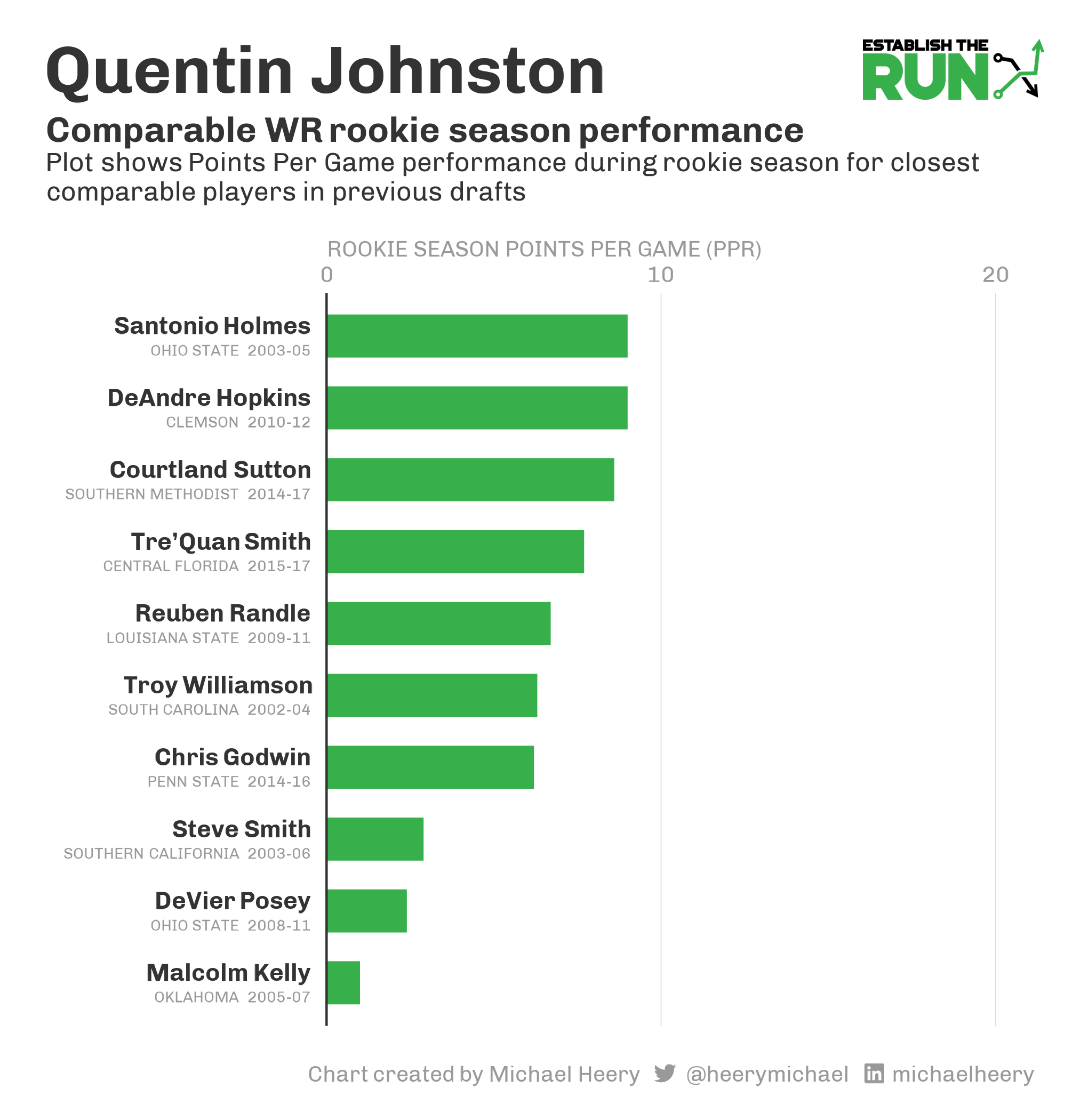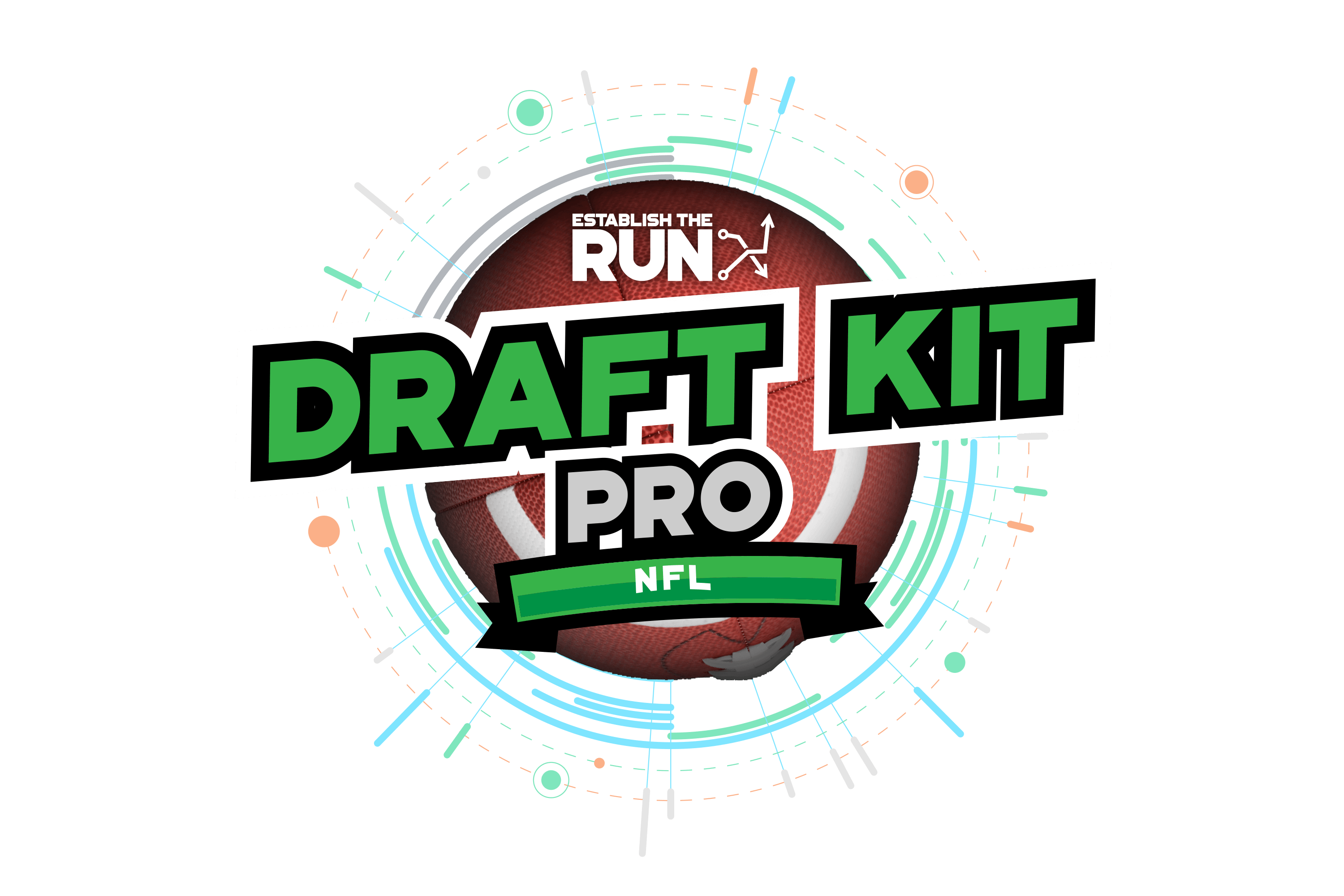Dynasty Outlook
March 9
Quentin Johnston is our WR3 for rookie drafts and checks in as WR24 in our overall dynasty ranks. He has a wide range of outcomes, as indicated by his player comps. He has an excellent physical profile, but there are some weaknesses in his game as indicated by the scouts. It is also somewhat alarming that Johnston has already missed a bunch of time in college. Because this class is not strong overall, Johnston is a risk worth taking in rookie drafts. The talents you need to pass up to take a swing on him are not overwhelming, and the WR1 upside is certainly there.
Profile Summary
Johnston is one of the few prototypes in terms of size in this WR class. He appears to have upper-percentile athleticism, which opens him up to having higher upside — something noted by the scouts. Johnston broke out at a young age but struggled with injuries in college. He will need to improve catching the ball to maximize his traits and hit on the higher range of his outcomes. There are a lot of players similar to Johnston who went on to be busts.
Vitals
Age (as of 12/31/22) — 21.3
Experience — 3 years
By the Numbers

Johnston was a four-star prospect who came in to produce immediately for the Horned Frogs. Despite playing in just eight of their 10 contests in his true freshman season, he was their leading receiver with 487 yards. As a sophomore, he again played in just eight games, but he was again their leading receiver. This time, it qualified as a breakout. 2022 was Johnston’s lone healthy season, and he posted his best raw yardage total — exceeding 1,000. However, he accounted for just six of the team’s 33 passing touchdowns.
His three-year career was relatively consistent, and Johnston was used minimally as a rusher. He did not contribute in the return game. For his career, Johnston averaged 19 yards per reception. He is one of 50 WRs since 2000 to average 18 or more yards per catch on at least 100 career catches. Of those 50, here are the players who were selected in Johnston’s draft range — outside the top 10 but inside the top 50:
Lee Evans
CeeDee Lamb
Bryant Johnson
Demaryius Thomas
Marquise Brown
Breshad Perriman
Jon Baldwin
Roddy White
Tee Higgins
Josh Reed
Devin Smith
This list makes Johnston look like a coin-flip type of prospect.
What the Scouts are Saying
Lance Zierlein remarked on the upside Johnston possesses:
Height-weight-speed prospect with the physical traits and upside that might have teams willing to overlook some of his inconsistencies on tape. Johnston is a long-striding vertical threat who can open up and separate when allowed to keep his feet moving in space. His elevation and catch radius create an expansive target area down the field, but his overall success rate on contested catches is way lower than it should be for a receiver of his size. Johnston needs a specific route tree, but he will improve in that area at the next level. He will benefit from a more accurate deep-ball quarterback, but he still feels more like a good WR2 than a high-volume WR1.
Daniel Jeremiah noted that Johnston needs to trust his hands better:
Johnston has exceptional size, speed, and production. He uses a variety of releases to defeat press coverage and gains ground in a hurry with his long, powerful stride. The TCU offense featured him on a lot of crossing routes and deep balls over the top. He amassed a large collection of explosive plays. Drops are his biggest issue. He doesn’t trust his hands, leading to way too many balls bouncing off his body and onto the turf. After the catch, he reminds me of Mike Williams with his long stride and power to break tackles. Overall, Johnston has ideal size and speed, but he needs to become a more reliable finisher with his hands.
Dane Brugler agrees with his peers on both the hands and the upside:
A freaky athlete for his size, Quentin Johnston has a unique combination of speed, strength, and tracking skills. He is raw at the top of routes and drops too many should-be completions, but Johnston can break tackles and offers the most upside of any receiver prospect in this class.
Draft Projection
Johnston currently has an expected draft position of 17.0 on Grinding the Mocks, which sources mock drafts around the interwebs. Mock Draft Database is a similar service that has Johnston 14th overall. He went 21st in Jeremiah’s most recent mock, and he did not make the first round in Brugler’s most recent mock. Johnston likely has a draft range from the middle of the first round to the middle of the second.
Comparable Players
I use Principal Component Analysis to evaluate prospects. In simplest terms, this kind of analysis looks at relevant data points to find the closest comparable players in past drafts. I prefer this to a model output — which yields only a single result — as it can display the possible range of outcomes for a prospect.
Note that the analysis itself isn’t telling us how good a player is; it is simply returning the most similar players. It is then up to us to layer in context and past results to see how good we think this player may be.

The comps indicate to us that Johnston has a tremendously wide range of outcomes. On the high end, we see elite fantasy producers like DeAndre Hopkins and Chris Godwin. These are good examples of who Johnston can become if he improves upon some of his shortcomings.
Santonio Holmes and Steve Smith had some short-term success during their careers. Courtland Sutton has had one good season so far and is about to turn 28.
The rest of the list is fairly disastrous. Tre’Quan Smith, Reuben Randle, Troy Williamson, Devier Posey, and Malcolm Kelly have little to no career production to speak of. These are the cautionary tales for big wideouts who don’t quite develop.



